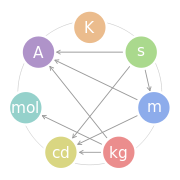Lumen (unit)
The lumen (symbol: lm) is the SI unit of luminous flux, a measure of the power of light perceived by the human eye. Luminous flux differs from radiant flux, the measure of the total power of light emitted, in that luminous flux is adjusted to reflect the varying sensitivity of the human eye to different wavelengths of light. The lumen is defined in relation to the candela by
That is, a light source that uniformly radiates one candela in all directions radiates a total of 4π lumens. If the source were partially covered by an ideal absorbing hemisphere, that system would radiate half as much luminous flux—only 2π lumens. The luminous intensity would still be one candela in those directions that are not obscured.
Contents |
Explanation
If a light source emits one candela of luminous intensity uniformly across a solid angle of one steradian, its total luminous flux emitted into that angle is one lumen. Alternatively, an isotropic one-candela light source emits a total luminous flux of exactly  lumens. The lumen can be thought of casually as a measure of the total "amount" of visible light in some defined beam or angle, or emitted from some source. The number of candelas or lumens from a source also depends on its spectrum, via the nominal response of the human eye as represented in the luminosity function.
lumens. The lumen can be thought of casually as a measure of the total "amount" of visible light in some defined beam or angle, or emitted from some source. The number of candelas or lumens from a source also depends on its spectrum, via the nominal response of the human eye as represented in the luminosity function.
A 23 watt compact fluorescent lamp emits about 1500–1600 lm.[1][2]
The difference between the units lumen and lux is that the lux takes into account the area over which the luminous flux is spread. A flux of 1000 lumens, concentrated into an area of one square metre, lights up that square metre with an illuminance of 1000 lux. The same 1000 lumens, spread out over ten square metres, produces a dimmer illuminance of only 100 lux. Mathematically, 1 lx = 1 lm/m2.
A single fluorescent light fixture that produces a luminous flux of 12000 lumens might light a residential kitchen with an illuminance of 500 lux. Lighting a larger area to the same illuminance requires a proportionately greater number of lumens.
Projector output
ANSI lumens
The light output of projectors (including video projectors) is typically measured in lumens. A standardized procedure for testing projectors has been established by the American National Standards Institute, which involves averaging together several measurements taken at different positions.[3] For marketing purposes, the luminous flux of projectors that have been tested according to this procedure may be quoted in "ANSI lumens", to distinguish them from those tested by other methods. ANSI lumen measurements are in general more accurate than the other measurement techniques used in the projector industry.[4] This allows projectors to be more easily compared on the basis of their brightness specifications.
The method for measuring ANSI lumens is defined in the IT7.215 document which was created in 1992. First the projector is set up to display an image in a room at a temperature of 25 degrees Celsius. The brightness and contrast of the projector are adjusted so that on a full white field, it is possible to distinguish between a 5% screen area block of 95% peak white, and two identically sized 100% and 90% peak white boxes at the center of the white field. The light output is then measured on a full white field at nine specific locations around the screen and averaged. This average is then multiplied by the screen area to give the brightness of the projector in "ANSI lumens".[5]
Peak lumens
Peak lumens is a measure of light output normally used with CRT video projectors. The testing uses a test pattern typically at either 10 and 20 percent of the image area as white at the center of the screen, the rest as black. The light output is measured just in this center area. Limitations with CRT video projectors result in them producing greater brightness when just a fraction of the image content is at peak brightness. For example the Sony VPH-G70Q CRT video projector produces 1200 "peak" lumens but just 200 ANSI lumens.[6]
SI photometry units
| Quantity | Symbol | SI unit | Abbr. | Notes | ||||
|---|---|---|---|---|---|---|---|---|
| Luminous energy | Qv | lumen second | lm·s | units are sometimes called talbots | ||||
| Luminous flux | F | lumen (= cd·sr) | lm | also called luminous power | ||||
| Luminous intensity | Iv | candela (= lm/sr) | cd | an SI base unit | ||||
| Luminance | Lv | candela per square metre | cd/m2 | units are sometimes called "nits" | ||||
| Illuminance | Ev | lux (= lm/m2) | lx | Used for light incident on a surface | ||||
| Luminous emittance | Mv | lux (= lm/m2) | lx | Used for light emitted from a surface | ||||
| Luminous efficacy | lumen per watt | lm/W | ratio of luminous flux to radiant flux | |||||
| See also SI · Photometry · Radiometry | ||||||||
See also
- Brightness
- Lux
References
- ↑ "Osram Dulux EL electronic energy-saving lamps" (pdf). Osram.dk. http://www.osram.dk/osram_dk/Professionelle/Brochurer_&_kataloger/Energispareprer_og_kompaktrr/e21_DULUX_EL_teknisk_guide.pdf. Retrieved Jan. 04, 2009.
- ↑ "Conventional CFLs". Energy Federation Incorporated. http://www.energyfederation.org/consumer/default.php/cPath/25_44_784. Retrieved 2008-12-23.
- ↑ "ANSI lumen article". PC Magazine Encyclopedia. http://www.pcmag.com/encyclopedia_term/0,2542,t=ANSI+lumen&i=37802,00.asp. Retrieved 2006-12-20.
- ↑ "Projector Guide". CPILive.net. February 2004. http://www.cpilive.net/news_ver2_old/guides_2004/projector_guide_issue_04/office.htm. Retrieved 2006-12-20.
- ↑ "ANSI method of light output measurement" (doc). 1993. http://www.hometheater1.com/tech/TB93-2.doc. Retrieved 2008-01-15.
- ↑ "Sony G70 Brochure". http://www.curtpalme.com/docs/SonyG70_Brochure.pdf.
|
||||||||||||||||||||
